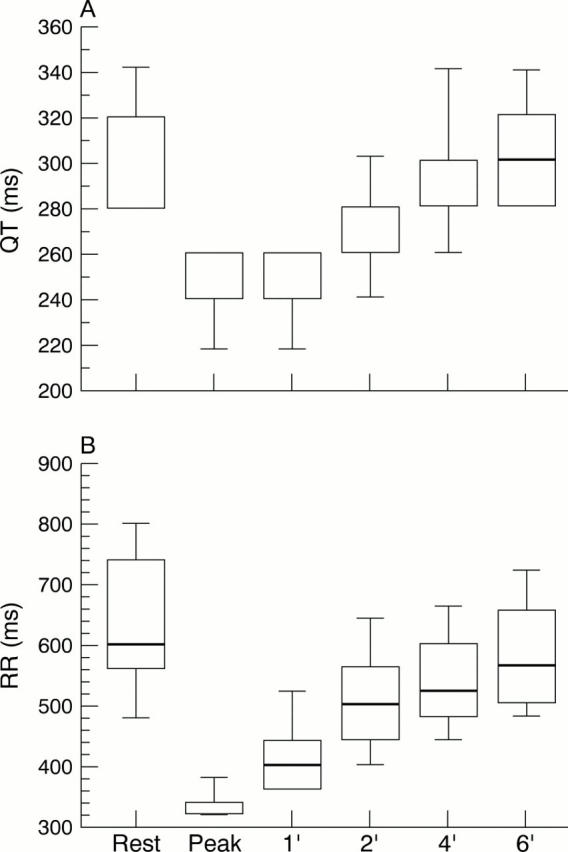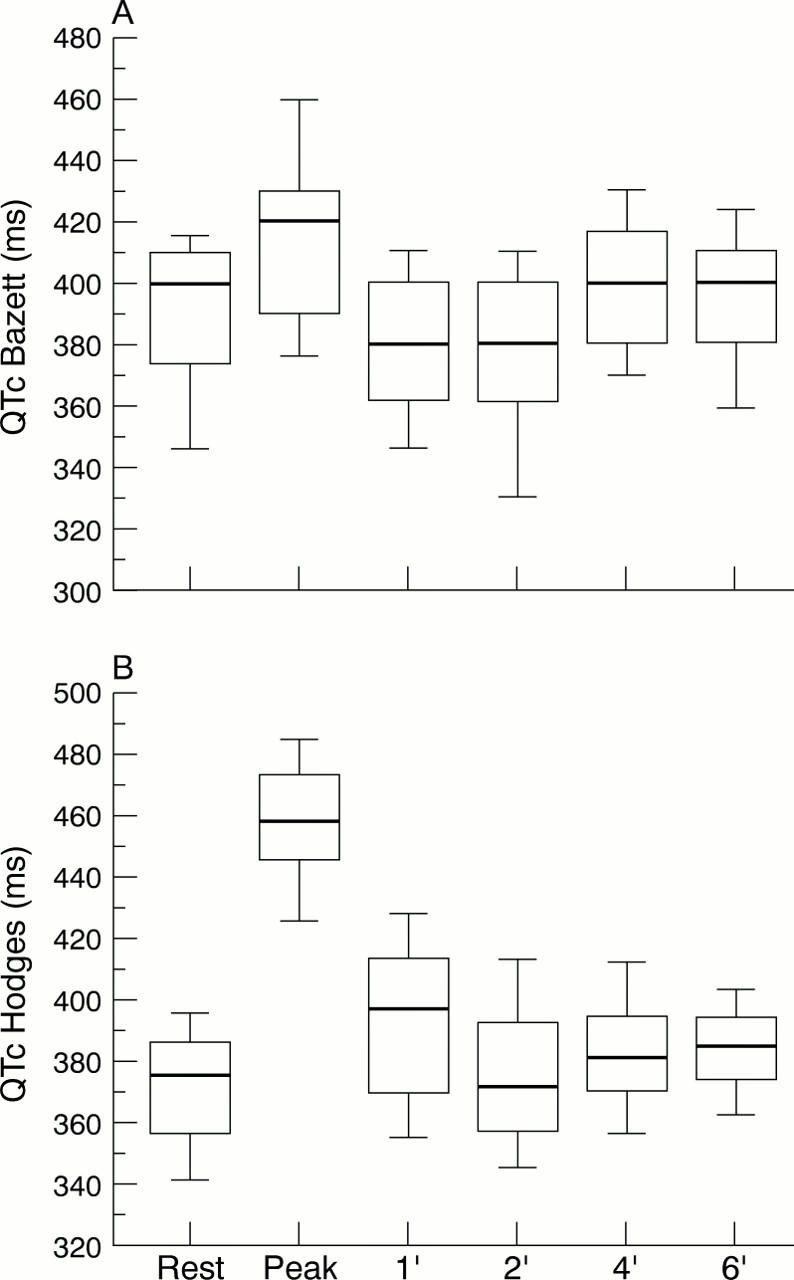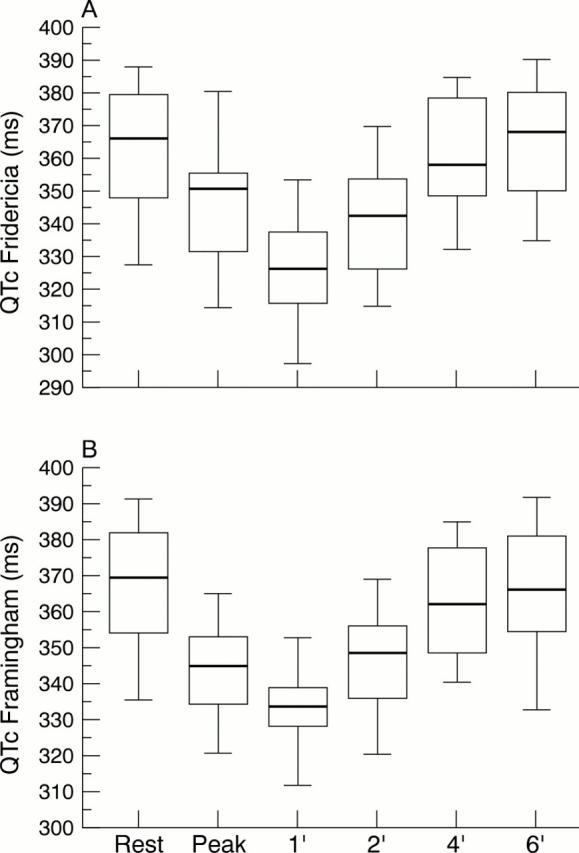Abstract
OBJECTIVE—To investigate the differences in four formulae for heart rate correction of the QT interval in serial ECG recordings in healthy children undergoing a graded exercise test. SUBJECTS—54 healthy children, median age 9.9 years (range 5.05-14.9 years), subjected to graded physical exercise (on a bicycle ergometer or treadmill) until heart rate reached > 85% of expected maximum for age. DESIGN—ECG was recorded at baseline, at maximum exercise, and at one, two, four, and six minutes after exercise. For each stage, a 12 lead digital ECG was obtained and printed. In each ECG, QT and RR interval were measured (lead II), heart rate was calculated, and QTc values were obtained using the Bazett, Hodges, Fridericia, and Framingham formulae. A paired t test was used for comparison of QTc, QT, and RR interval at rest and peak exercise, and analysis of variance for all parameters for different stages for each formula. RESULTS—From peak exercise to two minutes recovery there was a delay in QT lengthening compared with RR lengthening, accounting for differences observed with the formulae after peak exercise. At peak exercise, the Bazett and Hodges formulae led to prolongation of QTc intervals (p < 0.001), while the Fridericia and Framingham formulae led to shortening of QTc intervals (p < 0.001) until four minutes of recovery. The Bazett QTc shortened significantly at one minute after peak exercise. CONCLUSIONS—The practical meaning of QT interval measurements depends on the correction formula used. In studies investigating repolarisation changes (for example, in the long QT syndromes, congenital heart defects, or in the evaluation of new drugs), the use of an ad hoc selected heart rate correction formula may bias the results in either direction. The Fridericia and Framingham QTc values at one minute recovery from exercise may be useful in the assessment of long QT syndromes. Keywords: paediatric exercise testing; QT interval; QTc formulae
Full Text
The Full Text of this article is available as a PDF (123.2 KB).
Figure 1 .

(A) Absolute QT for the stages of exercise. (B) Absolute RR interval for the stages of exercise. Box plot explanation: upper horizontal line of box, 75th centile; lower horizontal line, 25th centile; horizontal bar within box, median; upper horizontal bar outside box, 90th centile; lower bar outside box, 10th centile.
Figure 2 .

(A) QTc Bazett during the different stages of exercise. (B) QTc Hodges for the different stages of exercise. Box plot explanation: upper horizontal line of box, 75th centile; lower horizontal line, 25th centile; horizontal bar within box, median; upper horizontal bar outside box, 90th centile; lower bar outside box, 10th centile.
Figure 3 .

(A) QTc Fridericia for the different stages of exercise. (B) QTc Framingham for the different stages of exercise. Box plot explanation: upper horizontal line of box, 75th centile; lower horizontal line, 25th centile; horizontal bar within box, median; upper horizontal bar outside box, 90th centile; lower bar outside box, 10th centile.
Selected References
These references are in PubMed. This may not be the complete list of references from this article.
- Ahnve S. Correction of the QT interval for heart rate: review of different formulas and the use of Bazett's formula in myocardial infarction. Am Heart J. 1985 Mar;109(3 Pt 1):568–574. doi: 10.1016/0002-8703(85)90564-2. [DOI] [PubMed] [Google Scholar]
- Hammond H. K., Froelicher V. F. Normal and abnormal heart rate responses to exercise. Prog Cardiovasc Dis. 1985 Jan-Feb;27(4):271–296. doi: 10.1016/0033-0620(85)90010-6. [DOI] [PubMed] [Google Scholar]
- Karjalainen J., Viitasalo M., Mänttäri M., Manninen V. Relation between QT intervals and heart rates from 40 to 120 beats/min in rest electrocardiograms of men and a simple method to adjust QT interval values. J Am Coll Cardiol. 1994 Jun;23(7):1547–1553. doi: 10.1016/0735-1097(94)90654-8. [DOI] [PubMed] [Google Scholar]
- Kawataki M., Kashima T., Toda H., Tanaka H. Relation between QT interval and heart rate. applications and limitations of Bazett's formula. J Electrocardiol. 1984 Oct;17(4):371–375. doi: 10.1016/s0022-0736(84)80074-6. [DOI] [PubMed] [Google Scholar]
- Kovács S. J., Jr The duration of the QT interval as a function of heart rate: a derivation based on physical principles and a comparison to measured values. Am Heart J. 1985 Oct;110(4):872–878. doi: 10.1016/0002-8703(85)90472-7. [DOI] [PubMed] [Google Scholar]
- Sagie A., Larson M. G., Goldberg R. J., Bengtson J. R., Levy D. An improved method for adjusting the QT interval for heart rate (the Framingham Heart Study) Am J Cardiol. 1992 Sep 15;70(7):797–801. doi: 10.1016/0002-9149(92)90562-d. [DOI] [PubMed] [Google Scholar]
- Schwartz P. J. Idiopathic long QT syndrome: progress and questions. Am Heart J. 1985 Feb;109(2):399–411. doi: 10.1016/0002-8703(85)90626-x. [DOI] [PubMed] [Google Scholar]
- Schwartz P. J., Periti M., Malliani A. The long Q-T syndrome. Am Heart J. 1975 Mar;89(3):378–390. doi: 10.1016/0002-8703(75)90089-7. [DOI] [PubMed] [Google Scholar]
- Surawicz B. U wave: facts, hypotheses, misconceptions, and misnomers. J Cardiovasc Electrophysiol. 1998 Oct;9(10):1117–1128. doi: 10.1111/j.1540-8167.1998.tb00890.x. [DOI] [PubMed] [Google Scholar]
- Swan H., Toivonen L., Viitasalo M. Rate adaptation of QT intervals during and after exercise in children with congenital long QT syndrome. Eur Heart J. 1998 Mar;19(3):508–513. doi: 10.1053/euhj.1997.0764. [DOI] [PubMed] [Google Scholar]
- Weintraub R. G., Gow R. M., Wilkinson J. L. The congenital long QT syndromes in childhood. J Am Coll Cardiol. 1990 Sep;16(3):674–680. doi: 10.1016/0735-1097(90)90359-w. [DOI] [PubMed] [Google Scholar]
- Yu P. N., Bruce R. A., Lovejoy F. W., Pearson R. OBSERVATIONS ON THE CHANGE OF VENTRICULAR SYSTOLE (QT INTERVAL) DURING EXERCISE. J Clin Invest. 1950 Mar;29(3):279–289. doi: 10.1172/JCI102255. [DOI] [PMC free article] [PubMed] [Google Scholar]


